Nursing Interventions for Managing Parkinson's Disease Symptoms
VerifiedAdded on 2020/07/23
|9
|2715
|31
Report
AI Summary
This report provides an overview of Parkinson's disease and the crucial role of nursing interventions in managing the condition. It begins with an introduction to Parkinson's disease, outlining its causes, symptoms, and the impact on patients. The report then presents a case study of a semi-retired individual named Philip, detailing his symptoms and diagnosis. The core of the report focuses on the interventions adopted by nurses, emphasizing constant patient assessment, ensuring proper diet and medication adherence, and providing mobility support. It highlights the importance of nurses in planning medication schedules, addressing dietary needs, assisting with mobility, and offering emotional support. The conclusion reiterates the significance of nursing interventions in alleviating symptoms and improving the quality of life for individuals with Parkinson's disease. The report also references relevant literature to support the findings.

Nursing
Paraphrase This Document
Need a fresh take? Get an instant paraphrase of this document with our AI Paraphraser
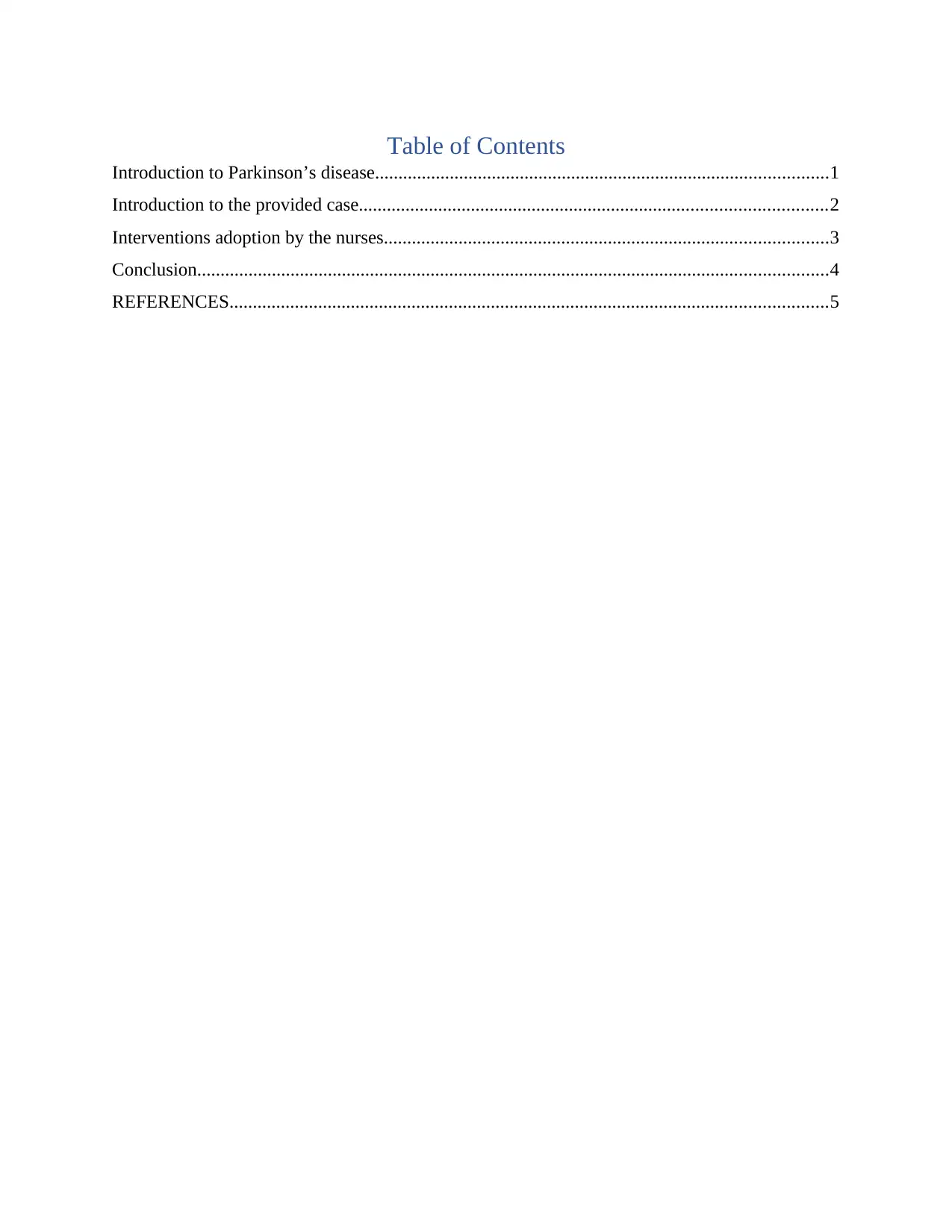
Table of Contents
Introduction to Parkinson’s disease.................................................................................................1
Introduction to the provided case....................................................................................................2
Interventions adoption by the nurses...............................................................................................3
Conclusion.......................................................................................................................................4
REFERENCES................................................................................................................................5
Introduction to Parkinson’s disease.................................................................................................1
Introduction to the provided case....................................................................................................2
Interventions adoption by the nurses...............................................................................................3
Conclusion.......................................................................................................................................4
REFERENCES................................................................................................................................5
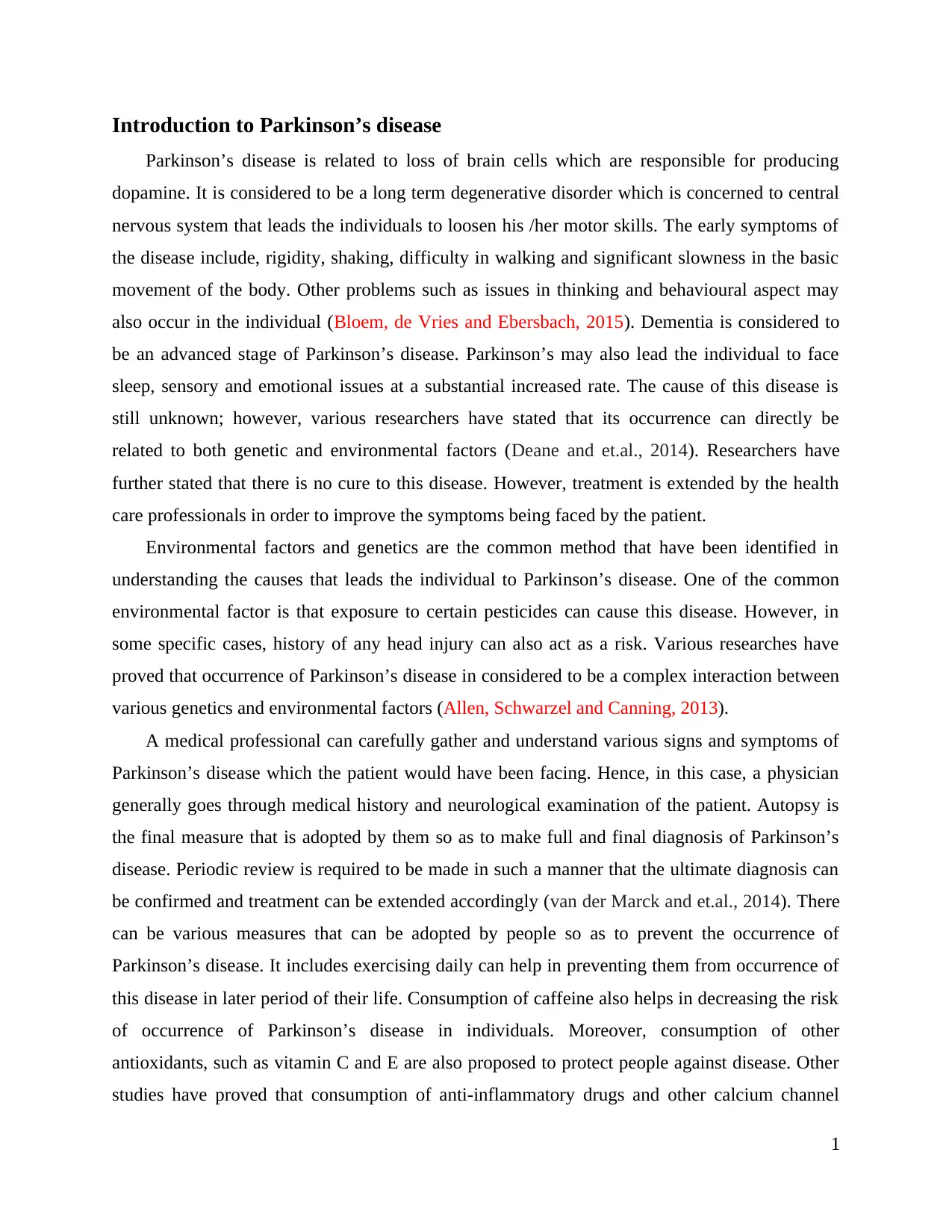
Introduction to Parkinson’s disease
Parkinson’s disease is related to loss of brain cells which are responsible for producing
dopamine. It is considered to be a long term degenerative disorder which is concerned to central
nervous system that leads the individuals to loosen his /her motor skills. The early symptoms of
the disease include, rigidity, shaking, difficulty in walking and significant slowness in the basic
movement of the body. Other problems such as issues in thinking and behavioural aspect may
also occur in the individual (Bloem, de Vries and Ebersbach, 2015). Dementia is considered to
be an advanced stage of Parkinson’s disease. Parkinson’s may also lead the individual to face
sleep, sensory and emotional issues at a substantial increased rate. The cause of this disease is
still unknown; however, various researchers have stated that its occurrence can directly be
related to both genetic and environmental factors (Deane and et.al., 2014). Researchers have
further stated that there is no cure to this disease. However, treatment is extended by the health
care professionals in order to improve the symptoms being faced by the patient.
Environmental factors and genetics are the common method that have been identified in
understanding the causes that leads the individual to Parkinson’s disease. One of the common
environmental factor is that exposure to certain pesticides can cause this disease. However, in
some specific cases, history of any head injury can also act as a risk. Various researches have
proved that occurrence of Parkinson’s disease in considered to be a complex interaction between
various genetics and environmental factors (Allen, Schwarzel and Canning, 2013).
A medical professional can carefully gather and understand various signs and symptoms of
Parkinson’s disease which the patient would have been facing. Hence, in this case, a physician
generally goes through medical history and neurological examination of the patient. Autopsy is
the final measure that is adopted by them so as to make full and final diagnosis of Parkinson’s
disease. Periodic review is required to be made in such a manner that the ultimate diagnosis can
be confirmed and treatment can be extended accordingly (van der Marck and et.al., 2014). There
can be various measures that can be adopted by people so as to prevent the occurrence of
Parkinson’s disease. It includes exercising daily can help in preventing them from occurrence of
this disease in later period of their life. Consumption of caffeine also helps in decreasing the risk
of occurrence of Parkinson’s disease in individuals. Moreover, consumption of other
antioxidants, such as vitamin C and E are also proposed to protect people against disease. Other
studies have proved that consumption of anti-inflammatory drugs and other calcium channel
1
Parkinson’s disease is related to loss of brain cells which are responsible for producing
dopamine. It is considered to be a long term degenerative disorder which is concerned to central
nervous system that leads the individuals to loosen his /her motor skills. The early symptoms of
the disease include, rigidity, shaking, difficulty in walking and significant slowness in the basic
movement of the body. Other problems such as issues in thinking and behavioural aspect may
also occur in the individual (Bloem, de Vries and Ebersbach, 2015). Dementia is considered to
be an advanced stage of Parkinson’s disease. Parkinson’s may also lead the individual to face
sleep, sensory and emotional issues at a substantial increased rate. The cause of this disease is
still unknown; however, various researchers have stated that its occurrence can directly be
related to both genetic and environmental factors (Deane and et.al., 2014). Researchers have
further stated that there is no cure to this disease. However, treatment is extended by the health
care professionals in order to improve the symptoms being faced by the patient.
Environmental factors and genetics are the common method that have been identified in
understanding the causes that leads the individual to Parkinson’s disease. One of the common
environmental factor is that exposure to certain pesticides can cause this disease. However, in
some specific cases, history of any head injury can also act as a risk. Various researches have
proved that occurrence of Parkinson’s disease in considered to be a complex interaction between
various genetics and environmental factors (Allen, Schwarzel and Canning, 2013).
A medical professional can carefully gather and understand various signs and symptoms of
Parkinson’s disease which the patient would have been facing. Hence, in this case, a physician
generally goes through medical history and neurological examination of the patient. Autopsy is
the final measure that is adopted by them so as to make full and final diagnosis of Parkinson’s
disease. Periodic review is required to be made in such a manner that the ultimate diagnosis can
be confirmed and treatment can be extended accordingly (van der Marck and et.al., 2014). There
can be various measures that can be adopted by people so as to prevent the occurrence of
Parkinson’s disease. It includes exercising daily can help in preventing them from occurrence of
this disease in later period of their life. Consumption of caffeine also helps in decreasing the risk
of occurrence of Parkinson’s disease in individuals. Moreover, consumption of other
antioxidants, such as vitamin C and E are also proposed to protect people against disease. Other
studies have proved that consumption of anti-inflammatory drugs and other calcium channel
1
⊘ This is a preview!⊘
Do you want full access?
Subscribe today to unlock all pages.

Trusted by 1+ million students worldwide
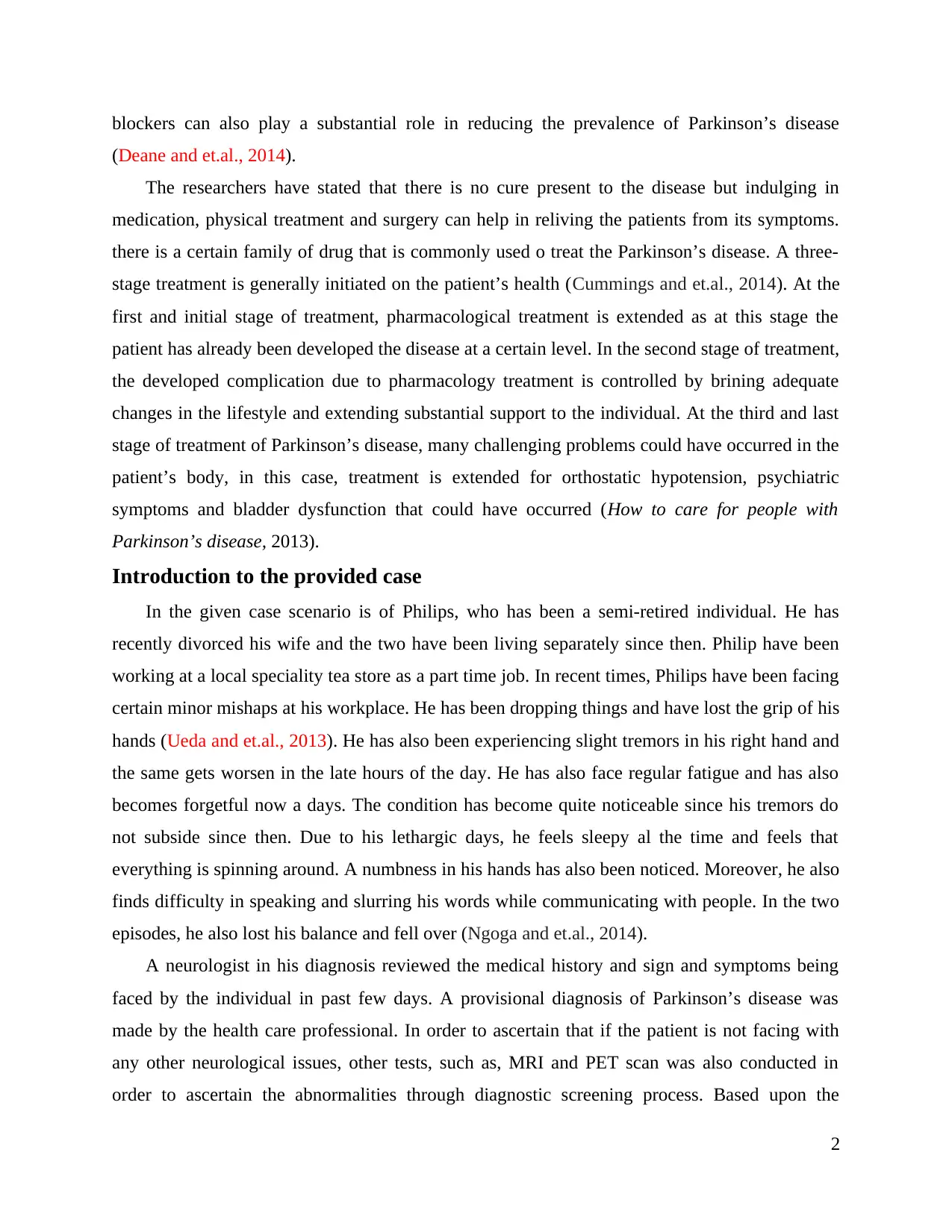
blockers can also play a substantial role in reducing the prevalence of Parkinson’s disease
(Deane and et.al., 2014).
The researchers have stated that there is no cure present to the disease but indulging in
medication, physical treatment and surgery can help in reliving the patients from its symptoms.
there is a certain family of drug that is commonly used o treat the Parkinson’s disease. A three-
stage treatment is generally initiated on the patient’s health (Cummings and et.al., 2014). At the
first and initial stage of treatment, pharmacological treatment is extended as at this stage the
patient has already been developed the disease at a certain level. In the second stage of treatment,
the developed complication due to pharmacology treatment is controlled by brining adequate
changes in the lifestyle and extending substantial support to the individual. At the third and last
stage of treatment of Parkinson’s disease, many challenging problems could have occurred in the
patient’s body, in this case, treatment is extended for orthostatic hypotension, psychiatric
symptoms and bladder dysfunction that could have occurred (How to care for people with
Parkinson’s disease, 2013).
Introduction to the provided case
In the given case scenario is of Philips, who has been a semi-retired individual. He has
recently divorced his wife and the two have been living separately since then. Philip have been
working at a local speciality tea store as a part time job. In recent times, Philips have been facing
certain minor mishaps at his workplace. He has been dropping things and have lost the grip of his
hands (Ueda and et.al., 2013). He has also been experiencing slight tremors in his right hand and
the same gets worsen in the late hours of the day. He has also face regular fatigue and has also
becomes forgetful now a days. The condition has become quite noticeable since his tremors do
not subside since then. Due to his lethargic days, he feels sleepy al the time and feels that
everything is spinning around. A numbness in his hands has also been noticed. Moreover, he also
finds difficulty in speaking and slurring his words while communicating with people. In the two
episodes, he also lost his balance and fell over (Ngoga and et.al., 2014).
A neurologist in his diagnosis reviewed the medical history and sign and symptoms being
faced by the individual in past few days. A provisional diagnosis of Parkinson’s disease was
made by the health care professional. In order to ascertain that if the patient is not facing with
any other neurological issues, other tests, such as, MRI and PET scan was also conducted in
order to ascertain the abnormalities through diagnostic screening process. Based upon the
2
(Deane and et.al., 2014).
The researchers have stated that there is no cure present to the disease but indulging in
medication, physical treatment and surgery can help in reliving the patients from its symptoms.
there is a certain family of drug that is commonly used o treat the Parkinson’s disease. A three-
stage treatment is generally initiated on the patient’s health (Cummings and et.al., 2014). At the
first and initial stage of treatment, pharmacological treatment is extended as at this stage the
patient has already been developed the disease at a certain level. In the second stage of treatment,
the developed complication due to pharmacology treatment is controlled by brining adequate
changes in the lifestyle and extending substantial support to the individual. At the third and last
stage of treatment of Parkinson’s disease, many challenging problems could have occurred in the
patient’s body, in this case, treatment is extended for orthostatic hypotension, psychiatric
symptoms and bladder dysfunction that could have occurred (How to care for people with
Parkinson’s disease, 2013).
Introduction to the provided case
In the given case scenario is of Philips, who has been a semi-retired individual. He has
recently divorced his wife and the two have been living separately since then. Philip have been
working at a local speciality tea store as a part time job. In recent times, Philips have been facing
certain minor mishaps at his workplace. He has been dropping things and have lost the grip of his
hands (Ueda and et.al., 2013). He has also been experiencing slight tremors in his right hand and
the same gets worsen in the late hours of the day. He has also face regular fatigue and has also
becomes forgetful now a days. The condition has become quite noticeable since his tremors do
not subside since then. Due to his lethargic days, he feels sleepy al the time and feels that
everything is spinning around. A numbness in his hands has also been noticed. Moreover, he also
finds difficulty in speaking and slurring his words while communicating with people. In the two
episodes, he also lost his balance and fell over (Ngoga and et.al., 2014).
A neurologist in his diagnosis reviewed the medical history and sign and symptoms being
faced by the individual in past few days. A provisional diagnosis of Parkinson’s disease was
made by the health care professional. In order to ascertain that if the patient is not facing with
any other neurological issues, other tests, such as, MRI and PET scan was also conducted in
order to ascertain the abnormalities through diagnostic screening process. Based upon the
2
Paraphrase This Document
Need a fresh take? Get an instant paraphrase of this document with our AI Paraphraser
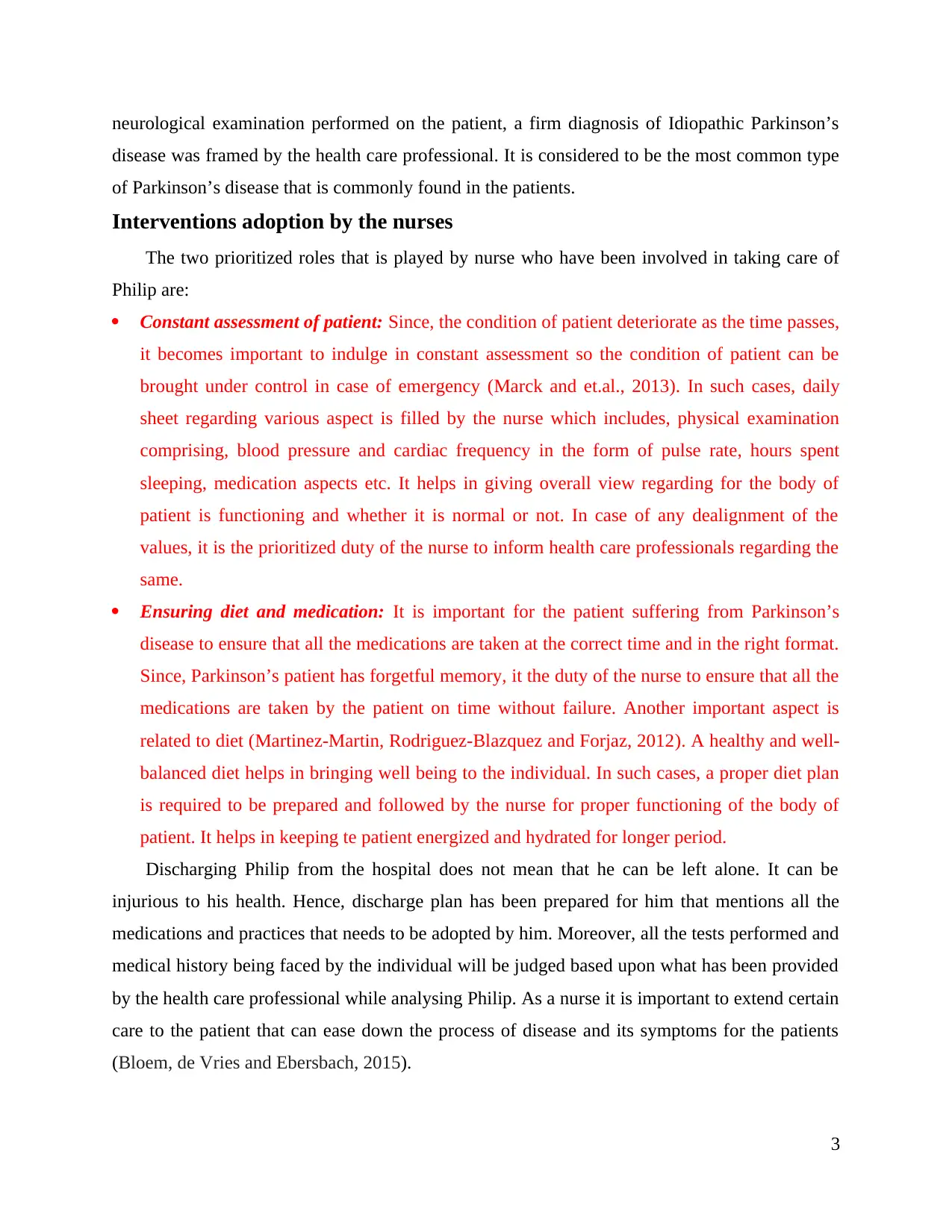
neurological examination performed on the patient, a firm diagnosis of Idiopathic Parkinson’s
disease was framed by the health care professional. It is considered to be the most common type
of Parkinson’s disease that is commonly found in the patients.
Interventions adoption by the nurses
The two prioritized roles that is played by nurse who have been involved in taking care of
Philip are:
Constant assessment of patient: Since, the condition of patient deteriorate as the time passes,
it becomes important to indulge in constant assessment so the condition of patient can be
brought under control in case of emergency (Marck and et.al., 2013). In such cases, daily
sheet regarding various aspect is filled by the nurse which includes, physical examination
comprising, blood pressure and cardiac frequency in the form of pulse rate, hours spent
sleeping, medication aspects etc. It helps in giving overall view regarding for the body of
patient is functioning and whether it is normal or not. In case of any dealignment of the
values, it is the prioritized duty of the nurse to inform health care professionals regarding the
same.
Ensuring diet and medication: It is important for the patient suffering from Parkinson’s
disease to ensure that all the medications are taken at the correct time and in the right format.
Since, Parkinson’s patient has forgetful memory, it the duty of the nurse to ensure that all the
medications are taken by the patient on time without failure. Another important aspect is
related to diet (Martinez-Martin, Rodriguez-Blazquez and Forjaz, 2012). A healthy and well-
balanced diet helps in bringing well being to the individual. In such cases, a proper diet plan
is required to be prepared and followed by the nurse for proper functioning of the body of
patient. It helps in keeping te patient energized and hydrated for longer period.
Discharging Philip from the hospital does not mean that he can be left alone. It can be
injurious to his health. Hence, discharge plan has been prepared for him that mentions all the
medications and practices that needs to be adopted by him. Moreover, all the tests performed and
medical history being faced by the individual will be judged based upon what has been provided
by the health care professional while analysing Philip. As a nurse it is important to extend certain
care to the patient that can ease down the process of disease and its symptoms for the patients
(Bloem, de Vries and Ebersbach, 2015).
3
disease was framed by the health care professional. It is considered to be the most common type
of Parkinson’s disease that is commonly found in the patients.
Interventions adoption by the nurses
The two prioritized roles that is played by nurse who have been involved in taking care of
Philip are:
Constant assessment of patient: Since, the condition of patient deteriorate as the time passes,
it becomes important to indulge in constant assessment so the condition of patient can be
brought under control in case of emergency (Marck and et.al., 2013). In such cases, daily
sheet regarding various aspect is filled by the nurse which includes, physical examination
comprising, blood pressure and cardiac frequency in the form of pulse rate, hours spent
sleeping, medication aspects etc. It helps in giving overall view regarding for the body of
patient is functioning and whether it is normal or not. In case of any dealignment of the
values, it is the prioritized duty of the nurse to inform health care professionals regarding the
same.
Ensuring diet and medication: It is important for the patient suffering from Parkinson’s
disease to ensure that all the medications are taken at the correct time and in the right format.
Since, Parkinson’s patient has forgetful memory, it the duty of the nurse to ensure that all the
medications are taken by the patient on time without failure. Another important aspect is
related to diet (Martinez-Martin, Rodriguez-Blazquez and Forjaz, 2012). A healthy and well-
balanced diet helps in bringing well being to the individual. In such cases, a proper diet plan
is required to be prepared and followed by the nurse for proper functioning of the body of
patient. It helps in keeping te patient energized and hydrated for longer period.
Discharging Philip from the hospital does not mean that he can be left alone. It can be
injurious to his health. Hence, discharge plan has been prepared for him that mentions all the
medications and practices that needs to be adopted by him. Moreover, all the tests performed and
medical history being faced by the individual will be judged based upon what has been provided
by the health care professional while analysing Philip. As a nurse it is important to extend certain
care to the patient that can ease down the process of disease and its symptoms for the patients
(Bloem, de Vries and Ebersbach, 2015).
3
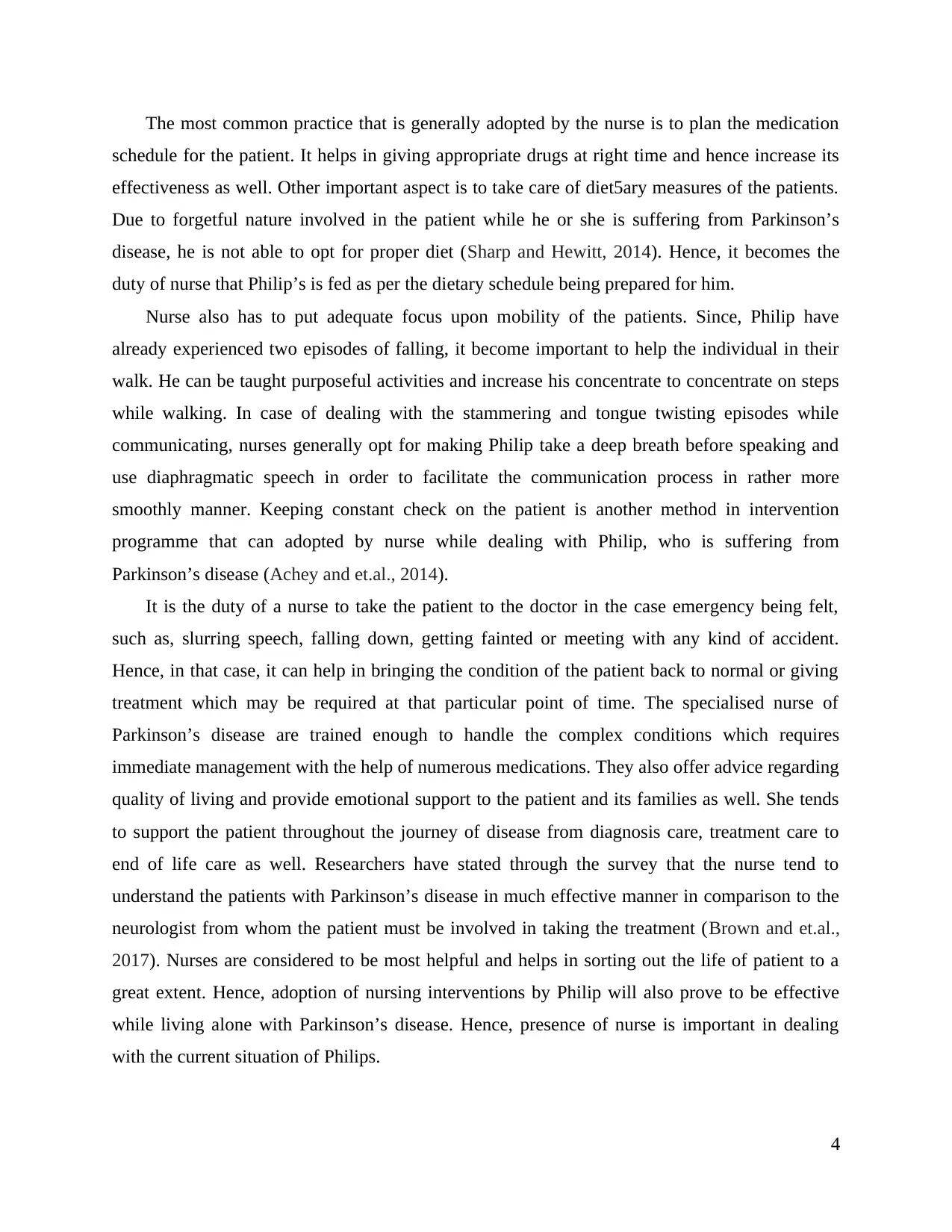
The most common practice that is generally adopted by the nurse is to plan the medication
schedule for the patient. It helps in giving appropriate drugs at right time and hence increase its
effectiveness as well. Other important aspect is to take care of diet5ary measures of the patients.
Due to forgetful nature involved in the patient while he or she is suffering from Parkinson’s
disease, he is not able to opt for proper diet (Sharp and Hewitt, 2014). Hence, it becomes the
duty of nurse that Philip’s is fed as per the dietary schedule being prepared for him.
Nurse also has to put adequate focus upon mobility of the patients. Since, Philip have
already experienced two episodes of falling, it become important to help the individual in their
walk. He can be taught purposeful activities and increase his concentrate to concentrate on steps
while walking. In case of dealing with the stammering and tongue twisting episodes while
communicating, nurses generally opt for making Philip take a deep breath before speaking and
use diaphragmatic speech in order to facilitate the communication process in rather more
smoothly manner. Keeping constant check on the patient is another method in intervention
programme that can adopted by nurse while dealing with Philip, who is suffering from
Parkinson’s disease (Achey and et.al., 2014).
It is the duty of a nurse to take the patient to the doctor in the case emergency being felt,
such as, slurring speech, falling down, getting fainted or meeting with any kind of accident.
Hence, in that case, it can help in bringing the condition of the patient back to normal or giving
treatment which may be required at that particular point of time. The specialised nurse of
Parkinson’s disease are trained enough to handle the complex conditions which requires
immediate management with the help of numerous medications. They also offer advice regarding
quality of living and provide emotional support to the patient and its families as well. She tends
to support the patient throughout the journey of disease from diagnosis care, treatment care to
end of life care as well. Researchers have stated through the survey that the nurse tend to
understand the patients with Parkinson’s disease in much effective manner in comparison to the
neurologist from whom the patient must be involved in taking the treatment (Brown and et.al.,
2017). Nurses are considered to be most helpful and helps in sorting out the life of patient to a
great extent. Hence, adoption of nursing interventions by Philip will also prove to be effective
while living alone with Parkinson’s disease. Hence, presence of nurse is important in dealing
with the current situation of Philips.
4
schedule for the patient. It helps in giving appropriate drugs at right time and hence increase its
effectiveness as well. Other important aspect is to take care of diet5ary measures of the patients.
Due to forgetful nature involved in the patient while he or she is suffering from Parkinson’s
disease, he is not able to opt for proper diet (Sharp and Hewitt, 2014). Hence, it becomes the
duty of nurse that Philip’s is fed as per the dietary schedule being prepared for him.
Nurse also has to put adequate focus upon mobility of the patients. Since, Philip have
already experienced two episodes of falling, it become important to help the individual in their
walk. He can be taught purposeful activities and increase his concentrate to concentrate on steps
while walking. In case of dealing with the stammering and tongue twisting episodes while
communicating, nurses generally opt for making Philip take a deep breath before speaking and
use diaphragmatic speech in order to facilitate the communication process in rather more
smoothly manner. Keeping constant check on the patient is another method in intervention
programme that can adopted by nurse while dealing with Philip, who is suffering from
Parkinson’s disease (Achey and et.al., 2014).
It is the duty of a nurse to take the patient to the doctor in the case emergency being felt,
such as, slurring speech, falling down, getting fainted or meeting with any kind of accident.
Hence, in that case, it can help in bringing the condition of the patient back to normal or giving
treatment which may be required at that particular point of time. The specialised nurse of
Parkinson’s disease are trained enough to handle the complex conditions which requires
immediate management with the help of numerous medications. They also offer advice regarding
quality of living and provide emotional support to the patient and its families as well. She tends
to support the patient throughout the journey of disease from diagnosis care, treatment care to
end of life care as well. Researchers have stated through the survey that the nurse tend to
understand the patients with Parkinson’s disease in much effective manner in comparison to the
neurologist from whom the patient must be involved in taking the treatment (Brown and et.al.,
2017). Nurses are considered to be most helpful and helps in sorting out the life of patient to a
great extent. Hence, adoption of nursing interventions by Philip will also prove to be effective
while living alone with Parkinson’s disease. Hence, presence of nurse is important in dealing
with the current situation of Philips.
4
⊘ This is a preview!⊘
Do you want full access?
Subscribe today to unlock all pages.

Trusted by 1+ million students worldwide
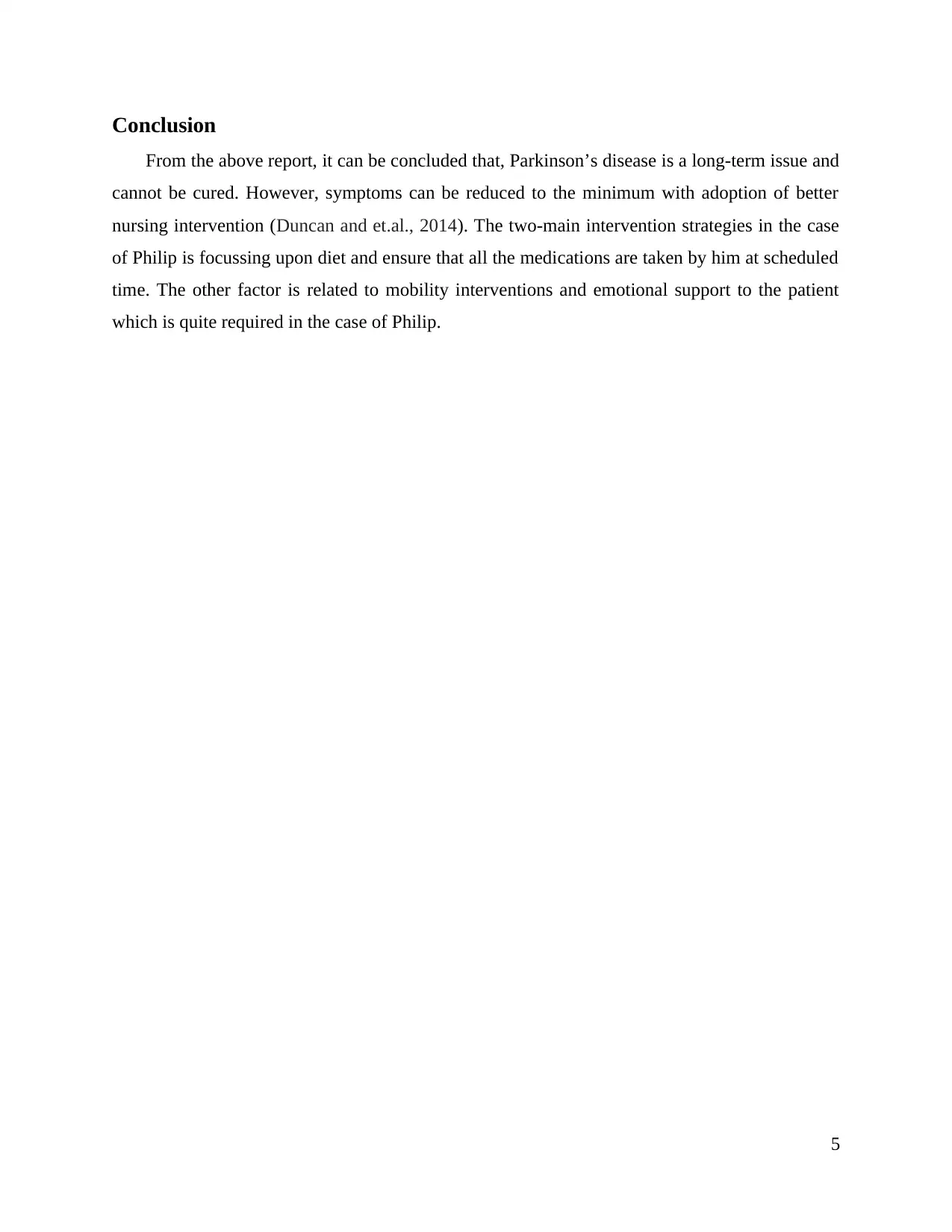
Conclusion
From the above report, it can be concluded that, Parkinson’s disease is a long-term issue and
cannot be cured. However, symptoms can be reduced to the minimum with adoption of better
nursing intervention (Duncan and et.al., 2014). The two-main intervention strategies in the case
of Philip is focussing upon diet and ensure that all the medications are taken by him at scheduled
time. The other factor is related to mobility interventions and emotional support to the patient
which is quite required in the case of Philip.
5
From the above report, it can be concluded that, Parkinson’s disease is a long-term issue and
cannot be cured. However, symptoms can be reduced to the minimum with adoption of better
nursing intervention (Duncan and et.al., 2014). The two-main intervention strategies in the case
of Philip is focussing upon diet and ensure that all the medications are taken by him at scheduled
time. The other factor is related to mobility interventions and emotional support to the patient
which is quite required in the case of Philip.
5
Paraphrase This Document
Need a fresh take? Get an instant paraphrase of this document with our AI Paraphraser
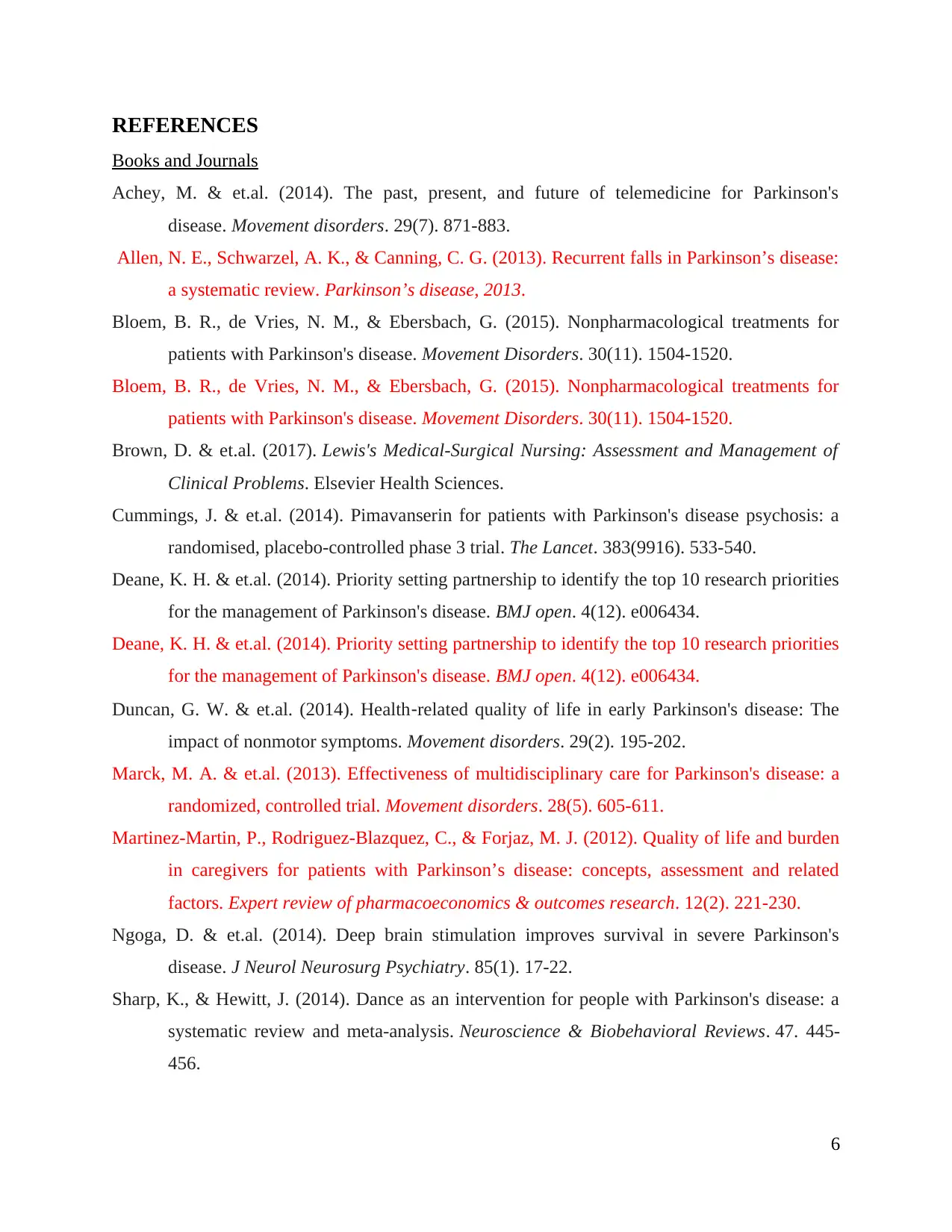
REFERENCES
Books and Journals
Achey, M. & et.al. (2014). The past, present, and future of telemedicine for Parkinson's
disease. Movement disorders. 29(7). 871-883.
Allen, N. E., Schwarzel, A. K., & Canning, C. G. (2013). Recurrent falls in Parkinson’s disease:
a systematic review. Parkinson’s disease, 2013.
Bloem, B. R., de Vries, N. M., & Ebersbach, G. (2015). Nonpharmacological treatments for
patients with Parkinson's disease. Movement Disorders. 30(11). 1504-1520.
Bloem, B. R., de Vries, N. M., & Ebersbach, G. (2015). Nonpharmacological treatments for
patients with Parkinson's disease. Movement Disorders. 30(11). 1504-1520.
Brown, D. & et.al. (2017). Lewis's Medical-Surgical Nursing: Assessment and Management of
Clinical Problems. Elsevier Health Sciences.
Cummings, J. & et.al. (2014). Pimavanserin for patients with Parkinson's disease psychosis: a
randomised, placebo-controlled phase 3 trial. The Lancet. 383(9916). 533-540.
Deane, K. H. & et.al. (2014). Priority setting partnership to identify the top 10 research priorities
for the management of Parkinson's disease. BMJ open. 4(12). e006434.
Deane, K. H. & et.al. (2014). Priority setting partnership to identify the top 10 research priorities
for the management of Parkinson's disease. BMJ open. 4(12). e006434.
Duncan, G. W. & et.al. (2014). Health‐related quality of life in early Parkinson's disease: The
impact of nonmotor symptoms. Movement disorders. 29(2). 195-202.
Marck, M. A. & et.al. (2013). Effectiveness of multidisciplinary care for Parkinson's disease: a
randomized, controlled trial. Movement disorders. 28(5). 605-611.
Martinez-Martin, P., Rodriguez-Blazquez, C., & Forjaz, M. J. (2012). Quality of life and burden
in caregivers for patients with Parkinson’s disease: concepts, assessment and related
factors. Expert review of pharmacoeconomics & outcomes research. 12(2). 221-230.
Ngoga, D. & et.al. (2014). Deep brain stimulation improves survival in severe Parkinson's
disease. J Neurol Neurosurg Psychiatry. 85(1). 17-22.
Sharp, K., & Hewitt, J. (2014). Dance as an intervention for people with Parkinson's disease: a
systematic review and meta-analysis. Neuroscience & Biobehavioral Reviews. 47. 445-
456.
6
Books and Journals
Achey, M. & et.al. (2014). The past, present, and future of telemedicine for Parkinson's
disease. Movement disorders. 29(7). 871-883.
Allen, N. E., Schwarzel, A. K., & Canning, C. G. (2013). Recurrent falls in Parkinson’s disease:
a systematic review. Parkinson’s disease, 2013.
Bloem, B. R., de Vries, N. M., & Ebersbach, G. (2015). Nonpharmacological treatments for
patients with Parkinson's disease. Movement Disorders. 30(11). 1504-1520.
Bloem, B. R., de Vries, N. M., & Ebersbach, G. (2015). Nonpharmacological treatments for
patients with Parkinson's disease. Movement Disorders. 30(11). 1504-1520.
Brown, D. & et.al. (2017). Lewis's Medical-Surgical Nursing: Assessment and Management of
Clinical Problems. Elsevier Health Sciences.
Cummings, J. & et.al. (2014). Pimavanserin for patients with Parkinson's disease psychosis: a
randomised, placebo-controlled phase 3 trial. The Lancet. 383(9916). 533-540.
Deane, K. H. & et.al. (2014). Priority setting partnership to identify the top 10 research priorities
for the management of Parkinson's disease. BMJ open. 4(12). e006434.
Deane, K. H. & et.al. (2014). Priority setting partnership to identify the top 10 research priorities
for the management of Parkinson's disease. BMJ open. 4(12). e006434.
Duncan, G. W. & et.al. (2014). Health‐related quality of life in early Parkinson's disease: The
impact of nonmotor symptoms. Movement disorders. 29(2). 195-202.
Marck, M. A. & et.al. (2013). Effectiveness of multidisciplinary care for Parkinson's disease: a
randomized, controlled trial. Movement disorders. 28(5). 605-611.
Martinez-Martin, P., Rodriguez-Blazquez, C., & Forjaz, M. J. (2012). Quality of life and burden
in caregivers for patients with Parkinson’s disease: concepts, assessment and related
factors. Expert review of pharmacoeconomics & outcomes research. 12(2). 221-230.
Ngoga, D. & et.al. (2014). Deep brain stimulation improves survival in severe Parkinson's
disease. J Neurol Neurosurg Psychiatry. 85(1). 17-22.
Sharp, K., & Hewitt, J. (2014). Dance as an intervention for people with Parkinson's disease: a
systematic review and meta-analysis. Neuroscience & Biobehavioral Reviews. 47. 445-
456.
6
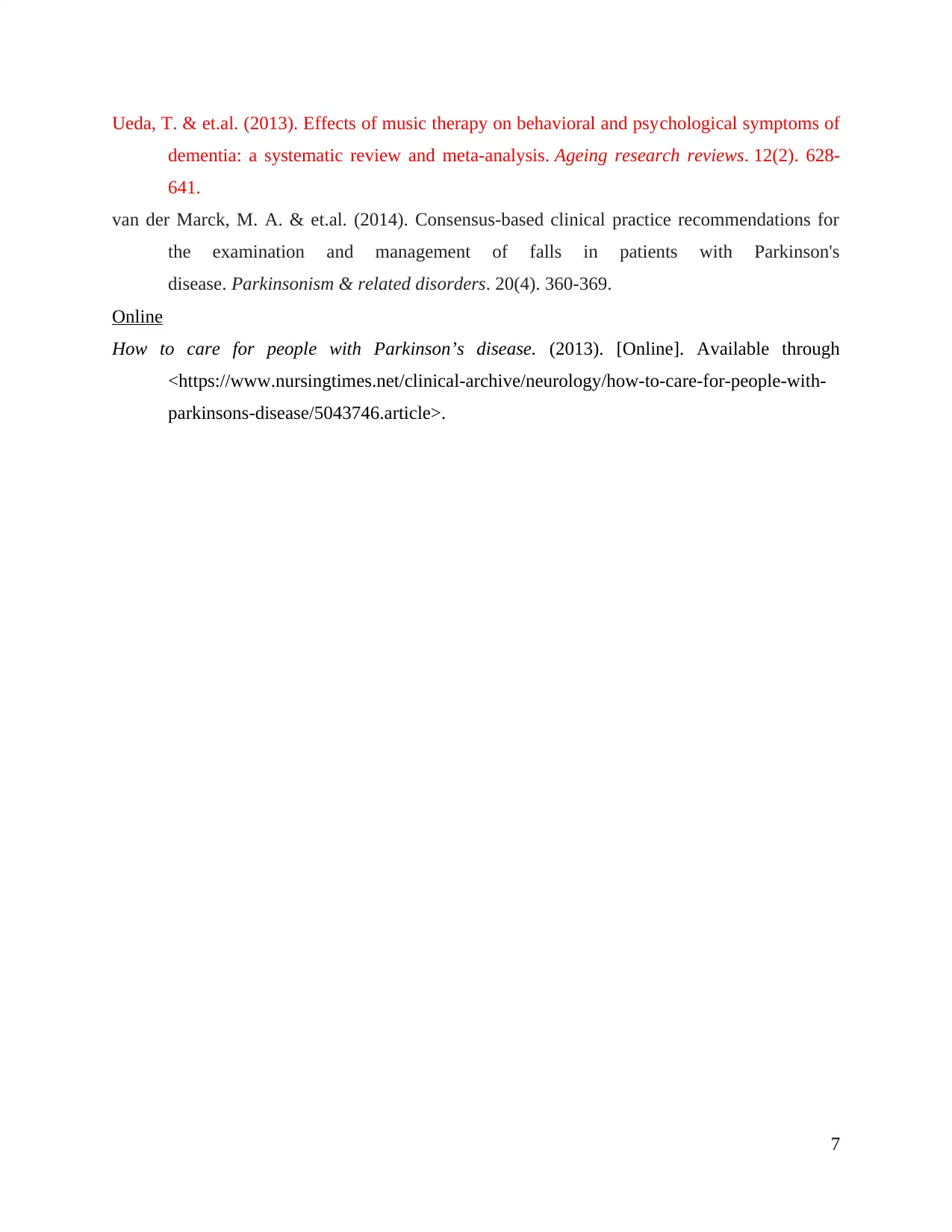
Ueda, T. & et.al. (2013). Effects of music therapy on behavioral and psychological symptoms of
dementia: a systematic review and meta-analysis. Ageing research reviews. 12(2). 628-
641.
van der Marck, M. A. & et.al. (2014). Consensus-based clinical practice recommendations for
the examination and management of falls in patients with Parkinson's
disease. Parkinsonism & related disorders. 20(4). 360-369.
Online
How to care for people with Parkinson’s disease. (2013). [Online]. Available through
<https://www.nursingtimes.net/clinical-archive/neurology/how-to-care-for-people-with-
parkinsons-disease/5043746.article>.
7
dementia: a systematic review and meta-analysis. Ageing research reviews. 12(2). 628-
641.
van der Marck, M. A. & et.al. (2014). Consensus-based clinical practice recommendations for
the examination and management of falls in patients with Parkinson's
disease. Parkinsonism & related disorders. 20(4). 360-369.
Online
How to care for people with Parkinson’s disease. (2013). [Online]. Available through
<https://www.nursingtimes.net/clinical-archive/neurology/how-to-care-for-people-with-
parkinsons-disease/5043746.article>.
7
⊘ This is a preview!⊘
Do you want full access?
Subscribe today to unlock all pages.

Trusted by 1+ million students worldwide
1 out of 9
Related Documents
Your All-in-One AI-Powered Toolkit for Academic Success.
+13062052269
info@desklib.com
Available 24*7 on WhatsApp / Email
![[object Object]](/_next/static/media/star-bottom.7253800d.svg)
Unlock your academic potential
Copyright © 2020–2025 A2Z Services. All Rights Reserved. Developed and managed by ZUCOL.





